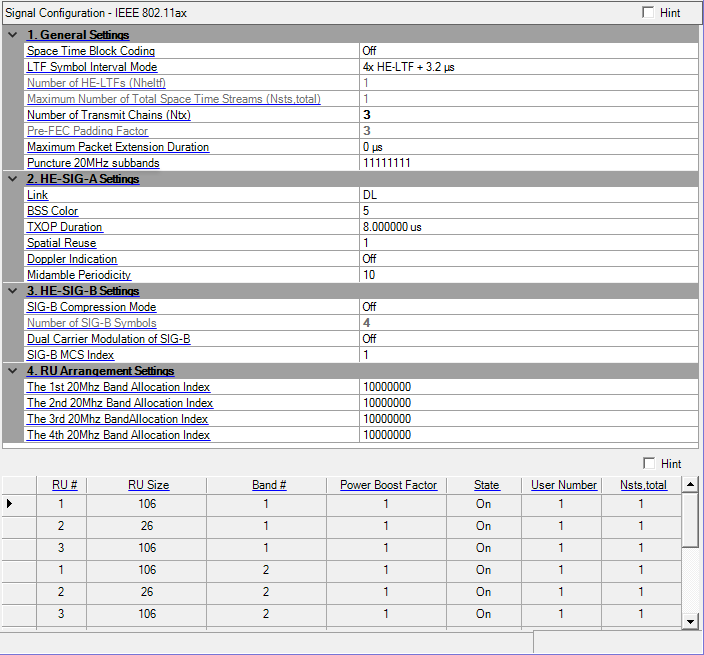
This topic applies to the following Generation Mode:
HE MU PPDU


Enable/disable space time block coding. STBC encoder spreads constellation points from Nss spatial stream into Nsts space-time streams using a space-time block code. STBC is allowed only with single spatial stream and two space-time streams.
Select the Symbol interval (with guard interval) for the HE-LTF field. The current combinations are 2x HE-LTF + 0.8 µs, 2x HE-LTF + 1.6 µs ,4x HE-LTF + 3.2 µs, and 4x HE-LTF + 0.8 µs.
Specify the number of HE-LTFs.
This is information indicating the total number of space time streams , which is equal to the sum of the Nsts for each user.
Set the number of transmit chains. When the number of instruments is more than 1 and the Channel State is Off, it automatically equals to the number of instruments and can't be changed, otherwise, it's editable.
Get or set the Pre-FEC Padding Factor.
Set or Get the Maximum Packet Extension Duration for Current PPDU.
Opens a ![]() dialog where you can puncture the 20-MHz bandwidth subbands. An unchecked box indicates the corresponding subband is punctured. The first 20-MHz subband cannot be punctured and the checkbox is inactive (grayed out). After closing the dialog, the parameter field represents punctured subbands as zeros (0) and unpuctured subbands as ones (1).
dialog where you can puncture the 20-MHz bandwidth subbands. An unchecked box indicates the corresponding subband is punctured. The first 20-MHz subband cannot be punctured and the checkbox is inactive (grayed out). After closing the dialog, the parameter field represents punctured subbands as zeros (0) and unpuctured subbands as ones (1).
Punctured subbands affect the RU allocation.
Bandwidth in HE-SIG-A (Table 28-19--HE-SIG-A field of an HE MU PPDU) is set to 4, 5, 6, or 7, according to the punctured subbands.
Indicates whether the frame is Uplink or Downlink. The field is set to DL for TDLS.
Get or Set the Base station identifier.The BSS Color field is an identifier of the BSS.
Set or Get the remaining time duration in the current TXOP. Set to 8449 μs to indicate no duration information. Set to value other than 8449 μs to indicate the duration information for NAV setting and protection of the TXOP. When the value ranges from 0 to 504 μs, the granularity is 8 μs. When the value ranges from 512 to 8448 μs, the granularity is 128 μs.
Indication of CCA Level, Interference Level accepted, TX Power.
Indicate a PPDU with enhanced immunity to Doppler.
Indicates midamble periodicity. The midamble is present only when the number of OFDM symbols in the HE Data field is larger than the signaled midamble periodicity plus 1 and Doppler Indication is set to on.
This compression bit is carried in the HE-SIG-A MU format to differentiate full BW MU-MIMO from OFDMA MU PPDU. When Enable indicate full band MU-MIMO.
Set the number of HE-SIG-B symbols. Its maximum value is 20, and minimum value is 1. The default value is 1.
Enable/disable dual sub-carrier modulation for payload of HE-SIG-B.
Select the MCS Index of HE-SIG-B. Only MCS0~MCS5 can be selected.
Get or Set the number of MU-MIMO users when SIGB compression mode is enabled.
Gets or sets the RU allocation signaling for the 1st 20 Mhz band.
For ![]() 40M bandwidth, the following two parameter names are available:
40M bandwidth, the following two parameter names are available:
For ![]() 80M bandwidth the two parameter name are available:
80M bandwidth the two parameter name are available:
The index for each Resource Unit of current resource unit allocation per 20 Mhz .
Select the resource unit (RU) size for current user, which could be 26, 52, 106, 242, 484, 996, or 2*996 sub carriers. Note that the instrument must have at least the equivalent bandwidth to allow the waveform to be successfully transmitted.
The band frequency index of current RU configuration.
Sets or gets the power boost factor of current RU. The default value is 1.0 for all RUs, which present 0 dB. For example, if you set 0.5 for current RU , which present 10log10(0.5.^2) = -6 dB.
Resource unit (RU) state.
Get the number of users for current resource unit.
Displays the Number of Space Time Streams (Nsts,u) of current user. When STBC is OFF, it is equal Nss,u. When STBC is ON, it equals 2 times Nss,u.
Range: -90 to 90 degrees
Set the baseband quadrature angle adjustment for Waveform 1 before channel fading and mirror spectrum.
The number of parameter groups depends on Number of Transmit Chains (Ntx). Each group is identified with an incremented waveform number, such as Waveform 1, Waveform 2, and so on.
Range: -10 to 10 dB
Set the baseband IQ gain balance for Waveform 1 before channel fading and mirror spectrum.
The number of parameter groups depends on Number of Transmit Chains (Ntx). Each group is identified with an incremented waveform number, such as Waveform 1, Waveform 2, and so on.